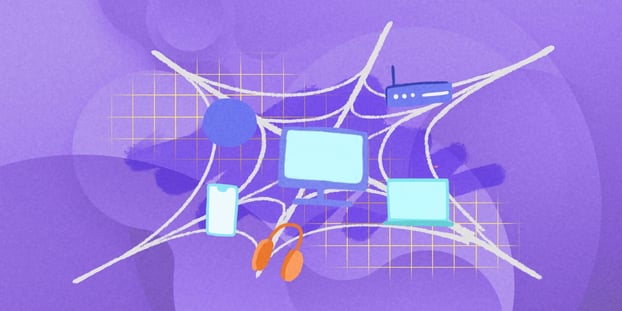If there's no proper offboarding process in place, organizations can easily lose track of the necessary steps to terminate a business relationship. This, of course, includes employees returning equipment and can be the cause of data and money loss.
Not retrieving equipment from workers can pose a severe security issue since devices can contain confidential information and credentials to multiple company platforms and cloud services. A report from Oomintza shows that half of the surveyed companies lost at least 5% of corporate-issued assets during offboarding.
However, this is something you can easily solve with InvGate Asset Management. By having an ITAM tool with your company’s hardware and software inventory, you’ll know in just a few clicks which devices are associated with a certain employee – and which software licenses will be available once they’re gone.
Find out how to successfully retrieve your company devices while offboarding employees using InvGate Asset Management.
How to manage employee returning equipment with InvGate Asset Management
The first step to knowing what company equipment to retrieve is to know the organization’s device fleet. With InvGate Asset Management’s comprehensive, detailed, and automated inventory of all the IT assets within your company, you have that covered.
But this is not enough. You also need to know which devices are assigned to which employees, and that’s also something you can do with our tool. Once you have your inventory in place, you can create relationships between the assets and the users that have them assigned.
So, with this complete map, IT support agents are ready to manage employee returning equipment. All they need to do is access the user profile on InvGate Asset Management to see:
- Hardware devices and software licenses assigned to a particular user.
- Non-IT assets assigned to a user (like office chairs, desktops, monitors, etc).
Moreover, asset managers can also access critical information about those IT assets, such as:
- The health status of the equipment
- Hardware details (manufacturer, processor, RAM, motherboard, storage capacity, etc.)
- Software information (OS, installed software)
- Financial information (available warranties and expiration date).
This will come in handy to check that the returned equipment hasn’t been altered and is in good shape to re-utilize, for instance.
Plus, if you have InvGate Asset Management integrated with InvGate Service Management, the HR team can include this step to check the assets to be recovered in their offboarding workflow to ensure this step is not skipped. And, of course, your asset managers will also have at hand any request associated with the asset to be returned, in case it needs some maintenance, for example.
3 best practices to retrieve company equipment
Employee offboarding is not the only scenario where organizations might need to recover IT assets. This can also happen if employees switch roles or departments. In any case, there are some best practices to manage employee returning equipment to ensure the timely return of physical assets.
1. Create a checklist of tasks to track the equipment return from workers
In general, it's essential to have a clear process for employee changes (which should be done by HR to contemplate every step of the workflow). However, the IT department can also have its checklist to standardize the necessary steps to proceed with retrieving.
This can include checking what assets are assigned to an employee, determining the best way to make the return effective, and deciding what are the next steps once the devices are back at the office (should you format the equipment, do some maintenance, discard it?).
2. Track metrics to ensure governance
If your company is big enough to include employee returning equipment as a regular task, then you'll need a system to manage it. And every system includes KPIs. Make sure not only to have the processes documented - so your whole team knows how to perform the task - but also select the KPIs to measure its success.
This will provide you with the parameters to support continual improvement, achieve more efficiency, and ultimately, governance.
3. Don't overcomplicate things
Offboarding is a coordinated process that typically includes several departments. So, it's complex by nature. Give teams the power to control their work in ways they prefer to do so, and try to keep complexities to a minimum to ensure a smooth workflow and achieve the primary objective: retrieve company equipment.
3 hardware recovery tips
You can put all the best practices to work, but people can still avoid returning company assets. For that reason, we created this quick list of hardware recovery tips to create a frictionless process.
- Make it as easy as possible - Shipping boxes, packing materials, postage-paid labels, and paying for the residential pick-up are some of the easiest ways to improve return rates.
- Use a WIIFM mindset - Focus on what’s in for the transitioning employee. If they have a notice period, use this time to work upstream and partner with people managers to get them to coordinate the return.
- Select your words carefully, but with a sense of urgency - Use subtle messaging changes to create urgency for the employee. For example, you might highlight the fact that their home office would be messy with all this extra equipment laying around, or mention that their next employer will be sending additional equipment and boxes for them to manage and store.
No matter the tactic you choose, building a great culture right from the start will also improve return rates. Employees will feel a sense of duty and dedication to help their colleagues out with a swift return. Plus, as your culture improves, you may also see more alumni staying involved with your organization. And gaining access to an alumni network is another valuable asset you can use to exchange for the return of the equipment.
Key takeaways
The offboarding of employees is a critical process that does not get the attention that it needs. As a consequence, besides the fact that 49% of companies lost at least 5% of corporate-issued assets during offboarding, 42% of organizations reported at least 5% instances of unauthorized access to SaaS and cloud resources after employee departure.
It’s not only a matter of money; it’s also a security issue. One of the many advantages of having an offboarding process in place is to protect your organization’s intellectual property. And that’s actually a challenge of employee transitions: managing workers’ data, system access, permissions, communication, and all the other ways in which they have built themselves into your organization.
No matter how hard it seems, having a proper offboarding process led by HR and actively supported by IT, Finances, and Legal will save you many headaches and money in the long run. Furthermore, through the process of removing access, applications, and other details, teams can capture this information and start to build role-based security, permissions, and application portfolio to improve the onboarding of the person replacing the previous worker.
Don't forget that you can see for yourself how InvGate Asset Management can help you manage your IT assets by requesting our 30-day free trial!















